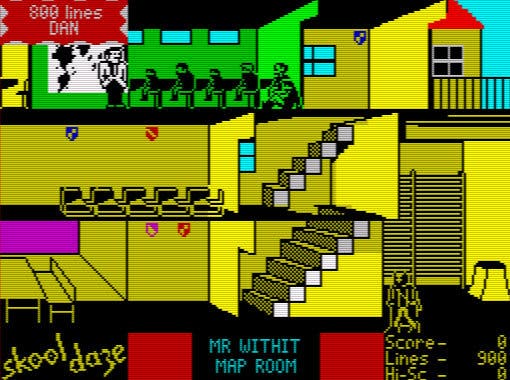Retrospective: Skool Daze and Back to Skool
Chalk and cheese.
That's assuming you weren't stuck in one of the classrooms with not enough seats forcing you into a game of musical chairs, with lines dished out every time you unavoidably got knocked on your arse. It's funny, but at the time we didn't even think of it as cruel, punitive design, more an accurate reflection of school being so unfair.
That imbalance was corrected in the sequel, aptly titled Back to Skool and released the same year. It's rather revealing that the biggest changes were stuff around the edges, more ways to muck about rather than a drastic evolution of the core gameplay.
Stink bombs and water pistols were overdue additions to Eric's arsenal, while sherry could be added to the teacher's tea to get them drunk and pissed-up on booze. More importantly, we were introduced to the girl's school next door, and Hayley, Eric's girlfriend. A couple of playtime smooches were enough to convince her to do some of your lines, reversing the inexorable trudge towards expulsion from the first game.

With the expanded map came more ambitious challenges, not least the daring bike jump over the school gate that allowed you to sneak into the girl's school and release a mouse, causing a near riot. It's moments like that, more than any item-hunting gameplay objective, that live on in the memory.
And that's the real genius of Skool Daze, and one of the reasons why I still think of it as one of the precursors to the openworld template that so many games utilise today. The school itself is anything but open, but the game wisely stepped back and let the player dictate their fate by allowing you to do pretty much whatever you wanted within the narrow confines of its tiny world.
It's perhaps no surprise that it was Rockstar who finally brought the spirit of Skool Daze back to gaming with its 2006 educational opus, Bully. The game paid tribute to the pioneering nature of its predecessor with multiple distractions and ways to cause mischief, but the soul was missing. The move to an American public school was part of it, losing the innocent, ramshackle charm of a very British location, but it was also missing a sense of innocence.

The protagonist of Bully was cynical and cool, an anti-hero who could grow up to star in a blistering action game with guns and explosions. But Skool Daze was never about the cool kids. It was about the survival of Eric the everyman (or boy), a game steeped in the comic strips of Leo Baxendale, a self-contained alternate world where dinner ladies were ogres, plates were piled high with bangers and mash, and cheeky kids yelled "Ooyah!" as they received a final panel slippering for their errant behaviour.
That world has long gone, swept away by the Americanisation of British school life and the stifling regimentation of Ofsted reports and nationwide educational initiatives. Nobody does lines any more. Scrawling graffiti on an interactive whiteboard just isn't the same. Yet Skool Daze lives on as an echo, a quaint combination of post-war schooling and post-punk anarchy that flourished, briefly and brilliantly, in the parochial backwash of pop culture that was the 1980s.
That, perhaps, makes it a perfect nostalgia piece. It's less about how school really was, more about how we imagined it to be and for all its gameplay innovations, the culture that made it unique, that gave it personality, simply no longer exists.








